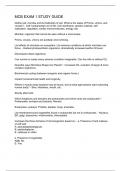MCB EXAM 1 STUDY GUIDE
Define cell, microbe and list hallmarks of cell. What is the status of Prions, virions, and viruses? - Cell: fundamental unit of life. Cell membrane, genetic material, self replication, regulation, similar macromolecules, energy use. Microbe: organism that cannot be seen without a microscope. Prions, viruses, virions are acellular and nonliving.
List effects of microbes on ecosystem. List extreme conditions at which microbes can thrive. - Earliest photosynthetic organisms, dramatically increased earths O2 level.
Decompose dead organisms. Can survive in nearly every extreme condition imaginable. Can live with or without O2.
Describe ways Microbes Shape Our Planet? - Increased O2, evolution of larger & more complex organisms. Biochemical cycling (between inorganic and organic forms.) Impact human/animal health and longevity.
Where in human body bacteria may be found, and at what age bacteria start colonizing human body? - Skin, intestines, mouth, etc. Shortly after birth.
Which kingdoms and domains are prokaryotes and which ones are eukaryotes? - Prokaryotes: archaea and bacteria. Monera.
Eukaryotes: eukarya. Protista, plantae, fungi, anamalia.
List membrane-bound organelles found in eukaryotes but not in prokaryotes. - Nucleus, ER, golgi, lysosomes, mitochondria, chloroplasts.
Compare the three domains of microorganism based on: - a. Presence of and makeup of cell wall
A: pseudopeptiodoglycan. B: peptiodoglycan. E: cellulose or chitin.
b. Presence of organelles
A&B: No. E: Yes c. Chromosome structure and organization A&B: Single circular. E: multiple linear
d. Compare the characteristics of bacteria and archaea
Both prokaryotic. A: found in extreme conditions and don't cause disease in humans.
Which domain of microorganisms may possess Hami? What is its possible use/role? - Hami are a network of cells that have a structure that makes them look like grappling hooks, suggesting they are involved in attaching cells to a surface. Exclusively produced by Archaeans.
List the six major bio element. List the ones present in each of the four polymers. - C, H,
O, N, P, S.
FA: C, H, O
CARBS: C, H, O
PROTEINS: C, H, O, N, SOMETIMES S
NA: C, H, O, N, P
List and define major chemical bonds used to connect biological molecules. - Ionic: electrons transferred
Covalent: electrons shared
Hydrogen: between hydrogen and F, O, N
Explain the role of water in biological activities. Define water activity aw, osmosis, osmolarity, and osmotolerant. Define halophiles. What strategy do they use to survive in the presence of high salt concentration? - Water plays a critical role in many biological activities bc the body is mostly made of water. Biochemical rxns almost always occur in water. Hydrogen bonding=high BP/good temperature buffer/excellent solvent.
Water activity (Aw): quantitative measure of the water availability in a habitat.
Osmosis: the movement of water through a semipermeable membrane from a low to high concentrated solution. (High to low water concentration.) Osmolarity: describes concentration of solute particles in a solution.




